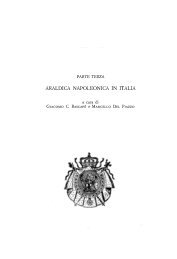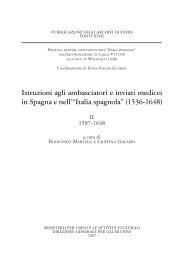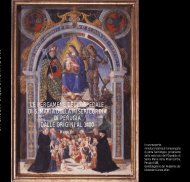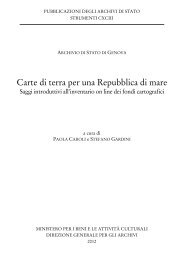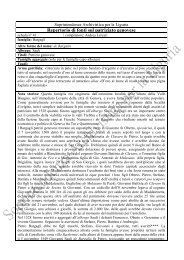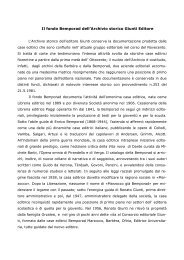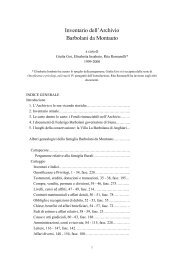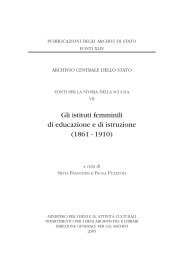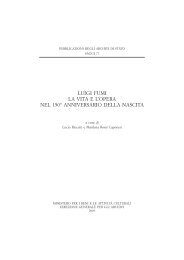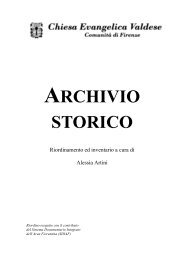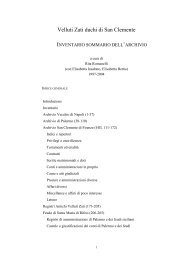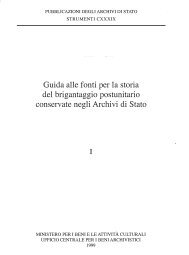esercito e città dall'unità agli anni trenta. tomo i - Sistema ...
esercito e città dall'unità agli anni trenta. tomo i - Sistema ...
esercito e città dall'unità agli anni trenta. tomo i - Sistema ...
You also want an ePaper? Increase the reach of your titles
YUMPU automatically turns print PDFs into web optimized ePapers that Google loves.
496 JOHN A. DAVIS<br />
(including the RRCC) to the wider issues that had provoked popular unrest<br />
and Pasquale Villari's praise for the way in which Heusch behaved in the<br />
aftermath of the emergency in Carrara does no t seem unjustified. It was also<br />
Villari who made the generai observation that:<br />
'In tutti questi tumulti italiani è sempre stata continuamente notata la insufficienza<br />
e la incapacità della nostra polizia la quale si lasciò sempre prendere<br />
alla sprovvista ... non sembra avere la più lontana idea dell'alto carattere morale<br />
che essa dovrebbe avere in un paese libero e civile' 30 .<br />
This judgement did not differ greatly from Crispi's own assessment of<br />
the PS service, and one conseguences of the crisis was that in 1894-5 the<br />
budget for the service was increased to l O. 5 million lire an d the senior ranks<br />
were thoroughly purged - 85 senior officers were retired and another 80<br />
sacked for incompetence:<br />
'Con l'eliminazione di gran parte del personale vecchio, inetto per condizioni<br />
fisiche, per scarsa cultura o per deplorevole condotta privata, e col temporaneo<br />
risanguinamento del personale di pubblica sicurezza con elementi<br />
giovani, vigorosi, educati secondo richiedono le nuove esigenze dei<br />
tempi. . .' 3 1 .<br />
Giolitti and the projessionalization of Urban Policing<br />
The crisis of the 1890s, and in particular the 'Fatti di Maggio' in Milan<br />
in 1898, served to accelerate the development of more specialist forms of<br />
urban policing, an d most of the features that Fosdick note d approvingly in<br />
his survey of 1911 dated from after this peri od 3 2. The reorganization of<br />
the PS forces that Crispi had begun did not begin to bear fruit until after<br />
1900, but it did ultimately lead to the establishment of more professionalized<br />
structures of policing in Italian citi es an d a sharper differentation between<br />
civil and military policing.<br />
The crisis of the 1890s had also revealed that the army was an extremely<br />
clusmy weapon to deploy even during moments of major urban distur-<br />
3° Cf. P. VILLANI, Scritti sulla Questione Sociale, Firenze 1902, p. 178-9; L. PELLOUX,<br />
Quelques souvenir de ma vie, ed. G. Manacorda, Roma 1967.<br />
31 ACSR, Carte Crispi, B. 47, Fasic. 694 (Doc. 5).<br />
32 See F. FosDICK, European Police Systems, New York 1911.<br />
THE ARMY AND PUBLIC ORDER IN ITALIAN 497<br />
bances, since its actions could easily exacerbate the disturbances they were<br />
designed to suppress. As has been noted, the actions of the military - particularly<br />
in Milan in 1898 - contributed to the popular anti-militarism that<br />
spread through many urban working class communities at the turn of the<br />
century.<br />
The expansion of the civil police force may therefore have been welcomed<br />
by many officers since it relieved them of a duty that was considered<br />
not only demeaning and a diversion from the preparation of the army as<br />
a fighting force, but also a dangerous cause of widespread hostility to an<br />
army that wished to project itself as a fundamental institution of national<br />
unity and cohesion.<br />
As John Whittam has argued 33 , the Giolittian era was as criticai for the<br />
development of the Italian army as for other institutions of Italian society.<br />
Since it was a period of important change in military technologies and<br />
strategies, but also one in which Giolitti's policies gave domestic investment<br />
a new priority on Italy's hard-pressed budget, it was not an easy period for<br />
the professional soldier. The years between.l898 and 1908 witnessed a new<br />
restlessness amongst an officer corps whose career opportunities were poor,<br />
and this may have spread to the ranks as well. It was certainly believed that<br />
ordinary soldiers were less willing to act as policemen and that there was<br />
deep resentment when they were deployed to break strikes.<br />
It must also be bome in mind, however, that the military authorities<br />
had become increasingly alarmed during the 1890s at the prospect of<br />
seditious ideas spreading amongst enlisted men 34 . This may w eli ha ve<br />
undermined their confidence in the willingness of the troops to perform<br />
policing duties. Together with the demands of technological progress this<br />
certainly contributed to the new interest shown in teaching and training conscripts,<br />
and in the strategy of 'istruzione di caserma' associated with Niccola<br />
Marselli 35. The concern to 'educate' and the fears of the diffusion of<br />
subversive ideas may well have served to make the garrison troops more<br />
isolated from the cities in which they were stationed.<br />
The government's non-interventionist policies in industriai relations after<br />
1901, meant that the use of troops (at least in the cities) became more restrained,<br />
however. It remained an axiom in Italy - as in other European states<br />
- that the army was the ultimate instrument in times of major civil comma-<br />
33 ]. WHITTAM, The Politics oj the Italian Army 1861-1918, London 1977, pp. 150-3.<br />
34 See eg. BOLTON K!NG & T. 0KEY, ltaly Today, London 1901, p. 72.<br />
3 5 L 'Esercito Italiano dal l o Tricolore al l o Centenario, Ufficio Storico dello Stato<br />
Maggiore, Roma 1961, p. 191.



